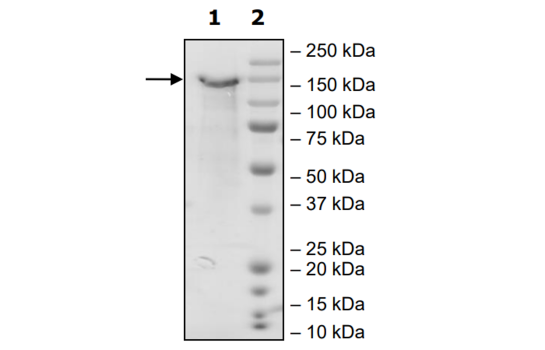LDLR, FLAG-Avi-Tag (Mouse) Recombinant
Catalog #
71222
$455
*
●
●
Purchase
Description
Mouse low density lipoprotein receptor (LDLR), also known as FH, FHC, and LDLCQ2, GenBank Accession No. NM_010700, a.a. 22-790, with C-terminal Flag-tag, MW=87 kDa87, expressed in a HEK293 cell expression system. *Note: LDLR is heavily glycosylated, resulting in higher molecular weight.
●
Synonyms
FH, FHC, LDLR, LDLCQ2, low density lipoprotein receptor
●
Product Data Gallery
Product Info
Storage and Usage
Citations
Species
Mouse
Host Species/Expression System
HEK293 cells
Purity
≥88%
Formulation
40 mM Tris HCl pH 8.0, 110 mM NaCl, 2.2 mM KCl, and 20% glycerol.
MW
87 kDa
Amino Acids
22-790 (end)
Genbank #
NM_010700
Background
The low density lipoprotein receptor (LDLR protein) gene family consists of cell surface proteins involved in receptor-mediated endocytosis of specific ligands. Low density lipoprotein (LDL) is normally bound at the cell membrane and taken into the cell ending up in lysosomes where the protein is degraded and the cholesterol is made available for repression of microsomal enzyme 3-hydroxy-3-methylglutaryl coenzyme A (HMG CoA) reductase, the rate-limiting step in cholesterol synthesis. At the same time, a reciprocal stimulation of cholesterol ester synthesis takes place. Mutations in this gene cause the autosomal dominant disorder, familial hypercholesterolemia. In case of HIV-1 infection, it functions as a receptor for extracellular Tat in neurons, mediating its internalization in uninfected cells. PCSK9 binds to the epidermal growth factor-like repeat A (EGF-A) domain of the LDLR protein, inducing LDLR degradation.
References
1. Holla, L., et al., BMC Cell Biol. 2007 Mar 1,8:9.
2. Qian, YW., et al., J Lipid Res. 2007 Jul,48(7):1488-98.
3. Fasano, T., et al., Athersclerosis. 2009 Mar,203(1):166-71.
2. Qian, YW., et al., J Lipid Res. 2007 Jul,48(7):1488-98.
3. Fasano, T., et al., Athersclerosis. 2009 Mar,203(1):166-71.


